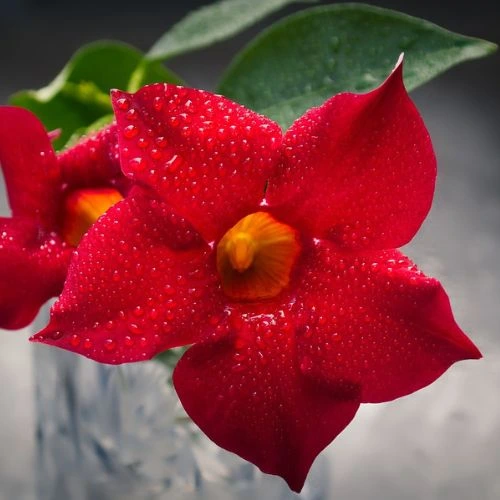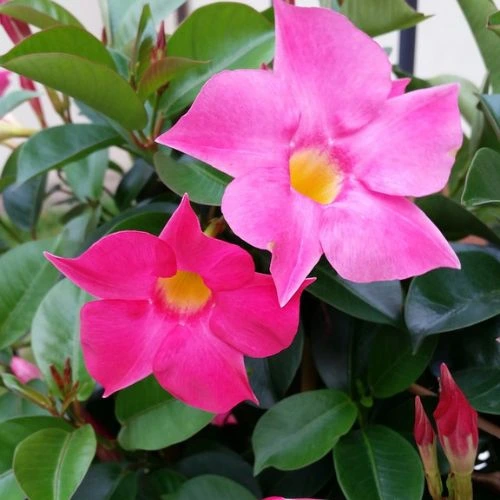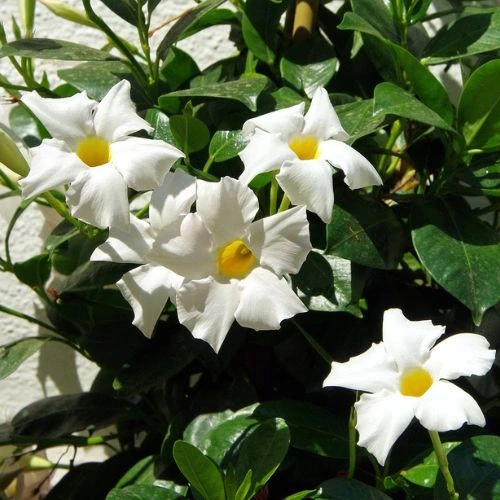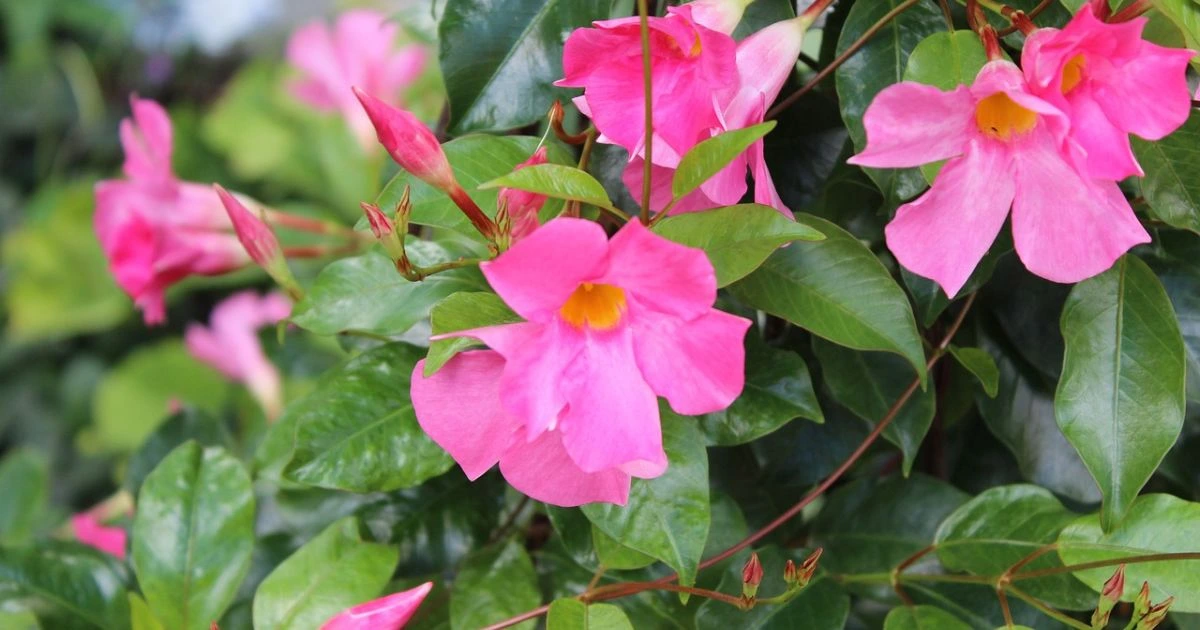In This Article
Introduction
Imagine stepping into your garden and being greeted by vivid, trumpet-shaped flowers cascading in a sea of green. The dipladenia bush can turn this dream into reality. Loved for its beauty and ease, it’s the perfect choice for gardeners seeking year-round charm without the hassle. Let’s dive into the ultimate guide to growing and caring for this vibrant gem!
What is a Dipladenia Bush?
The dipladenia bush is a tropical flowering plant known for its stunning blooms and compact, bushy structure. While it belongs to the Mandevilla family, it has distinct characteristics that make it unique. Here’s what you need to know:
- Native Origins: The dipladenia bush originates from South America, thriving in warm, tropical climates.
- Key Features: It has smaller, glossy leaves and a bushier growth habit compared to its vining Mandevilla relatives.
- Flower Colors: Its trumpet-shaped flowers come in vibrant shades of red, pink, and white, making it a popular choice for gardeners.
Why It’s Popular in the USA
The dipladenia bush is widely loved by American gardeners for several reasons:
- Climate Adaptability: Thrives in USDA zones 9-11, making it perfect for warmer regions.
- Year-Round Blooms: Produces flowers throughout the year in the right conditions.
- Versatility: Ideal for patios, balconies, and gardens due to its compact size.
Whether planted in containers or garden beds, the dipladenia bush adds a tropical flair to any outdoor space while requiring minimal maintenance. With its vibrant colors and manageable size, it’s a fantastic addition to gardens across the USA.



Best Dipladenia Bush Varieties for USA Gardens
The dipladenia bush offers a variety of stunning options to elevate your garden. Here are some top choices tailored for USA climates:
- Sun Parasol Crimson: Known for its deep red blooms, this variety adds a bold and dramatic flair to your garden.
- Pink Parfait: Featuring soft pink flowers, this variety brings a delicate, charming touch, perfect for patios and small spaces.
- White Delight: With elegant white blossoms, it creates a sophisticated, timeless look that complements any garden style.
Each of these varieties thrives in warm climates, offering vibrant, long-lasting blooms and minimal maintenance. Whether you’re planting in pots or garden beds, these dipladenias promise to transform your space into a tropical paradise.
Benefits of Growing a Dipladenia Bush
Adding a dipladenia bush to your garden offers numerous advantages, making it a favorite for both beginner and experienced gardeners. Here’s why this tropical beauty stands out:
1. Aesthetic Appeal
- Vibrant, trumpet-shaped flowers in shades of red, pink, and white.
- Shiny, green foliage forms a vivid contrast with the flowers.
- Perfect for adding tropical charm to patios, balconies, and garden beds.
2. Low Maintenance
- Requires minimal effort to thrive.
- Tolerates slight drought, making it suitable for busy gardeners.
- Resistant to many common pests and diseases with basic care.
3. Attracts Pollinators
- Bees and butterflies are attracted by its colorful blooms.
- Helps support local ecosystems by encouraging pollinator activity.
4. Space Efficiency
- With its compact form, it’s an excellent choice for tight garden spaces or container planting.
- Works well in hanging baskets or as a focal point in outdoor spaces.
5. Environmental Benefits
- Improves air quality by filtering out pollutants.
- Adds greenery and a calming effect to urban environments.
The dipladenia bush combines beauty, practicality, and eco-friendliness. Whether you’re looking to enhance your garden’s visual appeal or attract pollinators, this versatile plant is a fantastic choice for USA gardeners. Its low-maintenance nature ensures you’ll enjoy lush, vibrant blooms without the stress.
How to Plant a Dipladenia Bush
Planting a dipladenia bush is a straightforward process that ensures vibrant growth and stunning blooms. Follow these steps to give your plant the perfect start.
Choosing the Right Location
- Sunlight: Select a spot with full sun to partial shade for optimal growth. The ideal is being exposed to direct sunlight for at least 6 hours daily.
- Soil: Dipladenia thrives in well-drained soil. If your garden soil retains too much water, mix in sand or perlite to improve drainage.
- USDA Zones: Suitable for zones 9–11. In cooler climates, consider planting in a container to move it indoors during colder months.
Planting Steps
- Prepare the Soil
- Loosen the soil in your chosen spot and enrich it with organic compost. This process provides essential nutrients and promotes drainage.
- Dig the Hole
- Make a hole that’s double the size of the plant’s root ball in both width and depth. This allows room for root expansion.
- Position the Plant
- Remove the dipladenia bush from its pot, gently teasing the roots if they appear compacted. Set the plant in the hole, making sure the root ball’s top is flush with the surrounding soil.
- Backfill and Firm
- Fill the hole with soil, pressing gently in order to remove air pockets. To prevent rot, avoid burying the stem.
- Water Thoroughly
- Give your new plant a deep watering to settle the soil and hydrate the roots.
Pro Tips for Success
- Add a layer of mulch around the base in order to retain soil moisture and regulate temperature.
- Use a slow-release fertilizer at planting to support long-term growth.
Planting a dipladenia bush correctly lays the foundation for its healthy development. Whether in your garden or a decorative pot, this tropical beauty will reward you with lush blooms when planted with care.
Dipladenia Bush Care Tips
Proper care ensures your dipladenia bush thrives with lush, vibrant blooms. Here are essential tips to maintain its health and beauty.
Watering Needs
- Moderate Watering: Dipladenia bushes prefer slightly dry soil over consistently moist conditions. Between waterings, allow the topsoil dry.
- Avoid Overwatering: Too much water can lead to root rot, a common issue with tropical plants.
Fertilizing
- Best Fertilizers: Use a high-phosphorus fertilizer designed for flowering plants which especially encourages abundant blooms and healthy growth.
- Feeding Schedule: Fertilize every 2–3 weeks during the active growing season (spring and summer). Reduce feeding in fall and winter.
Pruning and Maintenance
- Trim Regularly: Prune overgrown stems in early spring to promote bushier growth and manage size.
- Remove Dead Foliage: Snip away dead or yellowing leaves to encourage new growth and keep the plant tidy.
Pest and Disease Control
- Common Pests: Watch out for aphids and spider mites, which can damage the leaves and stems.
- Natural Solutions: Neem oil is an effective organic remedy for pest infestations.
- Fungal Issues: To prevent fungal diseases, ensure good air circulation and avoid wetting the foliage during watering.
With these simple yet effective care practices, your dipladenia bush will reward you with vibrant flowers and healthy growth year-round. Regular attention to watering, feeding, and pruning ensures it remains a highlight of your garden.
How to Overwinter a Dipladenia Bush in the USA
The dipladenia bush thrives in warm climates but struggles in frost-prone regions. Overwintering it indoors ensures it survives the colder months, especially in areas outside USDA zones 9–11.
Indoor Transition
Before the first frost, move your dipladenia bush indoors to a bright spot, such as a south-facing window. If natural light is limited, supplement it with grow lights to maintain healthy foliage.
Adjust Watering
During winter, the plant enters dormancy, requiring less water. Allow the soil to dry out slightly between waterings, ensuring it remains moist but never soggy. Avoid overwatering to prevent root rot.
Temperature and Humidity
Keep the indoor temperature between 60–75°F to mimic its native tropical environment. Use a humidifier or place a tray of water near the plant to maintain moderate humidity levels, as dry indoor air can stress it.
Minimal Fertilizing
Reduce feeding during winter dormancy. Resume regular fertilization in early spring to prepare the plant for active growth and blooming.
By following these steps, your dipladenia bush will stay healthy indoors and be ready to thrive once replanted outdoors in spring. This seasonal care ensures your plant remains a stunning centerpiece in your garden for years to come.
Common Problems and How to Solve Them
Even though the dipladenia bush is known for its low-maintenance nature, occasional challenges may arise. Here are common issues and practical solutions to keep your plant thriving.
Yellowing Leaves
This is often caused by overwatering or a nutrient deficiency. To fix this, check the soil moisture—allow the top layer to dry before watering again. Apply a balanced fertilizer to restore nutrients and ensure healthy growth.
No Flowers
If your dipladenia bush isn’t blooming, it may lack sufficient sunlight or have been over-fertilized with nitrogen. Relocate the plant to a spot with bright, indirect light for at least six hours daily. Use a high-phosphorus fertilizer to encourage blooms instead of foliage growth.
Drooping or Wilting
Wilting usually indicates underwatering or a root-bound plant. Check the soil—if it’s dry, water the plant thoroughly and maintain consistent moisture levels. If the roots are tightly packed, consider repotting into a larger container to give them more room to grow.
Pests and Diseases
Common pests include aphids and spider mites, while fungal infections may develop in humid conditions. Combat pests by applying neem oil or insecticidal soap. For fungal issues, prune affected areas and treat with a fungicide spray.
By addressing these issues promptly, you can ensure your dipladenia bush stays healthy and continues to produce its vibrant, trumpet-shaped flowers, enhancing your garden’s beauty year-round.
Dipladenia Bush FAQs
- Q1 – Is a Dipladenia bush perennial or annual?
- The dipladenia bush is a perennial in warm climates, thriving year-round in USDA zones 9-11. However, in cooler regions, it’s often treated as an annual unless overwintered indoors.
- Will Dipladenia survive inside?
- Yes, the dipladenia bush can survive indoors if provided with adequate light and warmth. Place it near a bright, sunny window and reduce watering during the winter months to mimic its natural dormancy period.
- Does Dipladenia grow fast?
- Yes, the dipladenia bush is a relatively fast grower under ideal conditions. With plenty of sunlight, well-drained soil, and consistent care, it can produce lush foliage and vibrant blooms in no time.
- Why isn’t my Dipladenia blooming?
- A lack of blooms usually indicates insufficient sunlight or over-fertilization with nitrogen. Relocate your plant to a sunnier spot with at least six hours of light daily. To encourage flowering, use a high-phosphorus fertilizer.
- Why is my Dipladenia plant dying?
- Common causes of a dying dipladenia bush include overwatering, underwatering, or pest infestations. Check soil moisture levels, ensure proper drainage, and inspect the plant for pests like aphids or spider mites.
- How do you make a Dipladenia bushy?
- To encourage a bushier growth habit, pinch back the tips of the plant in early spring or summer. This stimulates branching and creates a fuller, more compact appearance. Moreover, Regular pruning helps maintain its shape and vitality.
Conclusion
The dipladenia bush combines effortless elegance with practicality, making it a must-have for USA gardens. Start your journey with this lush, blooming beauty today. For more gardening tips and inspiration, subscribe to our newsletter and let’s cultivate a flourishing garden together!

